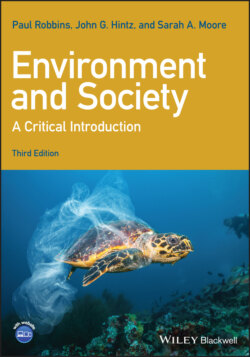Читать книгу Environment and Society - Paul Robbins - Страница 24
A Booming China or a Busting One?
ОглавлениеThe People’s Republic of China has long been a place in the world singled out for environmental concern. With a population of almost 1.4 billion people, or about 18% of the people on Earth, and a growing industrial economy, this would seem to make sense. While China is far lower in per capita greenhouse gas emissions (roughly 9 metric tons of CO2 equivalent for each person compared to around 20 metric tons in the United States), the Chinese economy produces a whopping 27% of total global greenhouse gases). Numbers have power.
Those who approach environmental questions through these kinds of numbers also see a growth trend and a pattern of accompanying industrialization that causes them worry. China had only a half billion people in 1950, while today there are triple that number. With each new person comes more demand for limited available water, the production of mounds of garbage, and the disturbance of large areas for new home construction. The 340 million motor vehicles in China, including 250 million cars, each emit roughly their own weight in greenhouse gases per year, contributing seriously to both local air pollution and global climate change. The dramatic rate of population growth poses obvious questions about the limits of the land, water, and air to support the nation.
Still, there is more than just the number of people to concern us here. Water consumption in China is around 800 gallons per person every day (where the US consumes more than 2200 gallons per capita daily), a number far surpassing that of most places on Earth; for most sub-Saharan African countries the average is closer to half gallon. With an increasingly affluent and large population, China – like the United States – definitely has a major environmental impact.
But these raw numbers and their apparent demographic drivers can be enormously deceptive. First, a significant proportion of water use and greenhouse gas emissions, among other areas of heavy environmental impact, are driven by the export of resources, industrial materials, and consumer good consumed elsewhere. Where less than 10% of water use, for example, is domestically consumed there, roughly 30% goes to industrial production. With exports to places like the European Union, North America, and elsewhere in the world, the population of China seems to be a far less major source of environmental woes than the circulation of the global economy itself.
So too, the population growth rate of China is at an all-time low. While in 2020 China’s population will continue to experience a net gain, and some seven million more people will live in the country by then end of that year than the beginning, the growth rate is actually only about 0.5%. That compares to growth in 1969, which peaked at a staggering 2.8%. China has essentially stopped growing, and is headed for contraction (see Box 2.1 ). The country is likely to begin shrinking in this century. With fewer young people entering the economy to support the aging population, all kinds of new issues attend the “population bust.” Yet fears of runaway over-population impacting the environment need some careful reconsideration (Robbins and Smith 2017).
